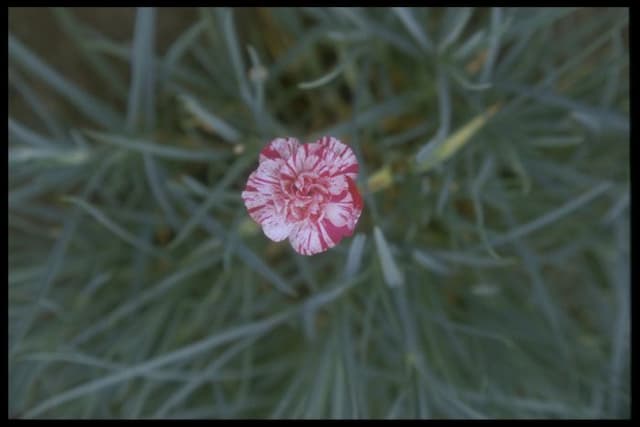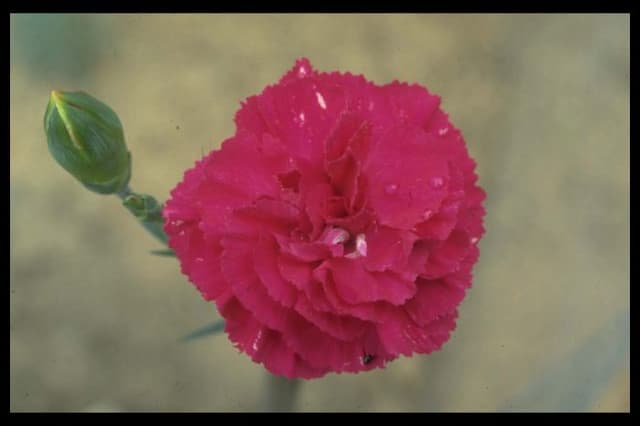German Catchfly Lychnis viscaria 'Splendens Plena' (d)

ABOUT
The Lychnis viscaria 'Splendens Plena', commonly known as the German catchfly, is a striking perennial plant noted for its showy appearance. It produces clusters of brilliant, double-flowered blooms that exhibit a deep, rich pink or magenta hue, which gives the plant a vibrant splash of color. The individual flowers are densely packed with petals, creating a full, rounded look that resembles a small, ruffled pom-pom. The foliage of the German catchfly is equally appealing, with lance-shaped leaves that have a slightly hairy texture. The leaves are typically a bright green color, providing a lush backdrop to the vivid blooms. The stems are sticky, which is a characteristic feature of the plant and is also the origin of the name "catchfly," as small insects often get caught on the sticky surface. Overall, the German catchfly is a charming and attractive plant, with its abundant, frilly flowers and verdant leaves making it a standout addition to any garden setting. Its ability to catch the eye with its delightful rosettes of petals contributes to its popularity among garden enthusiasts who seek to add a decorative touch and a pop of intense color to their outdoor spaces.
About this plant
 Names
NamesSynonyms
Catchfly, Sticky Catchfly, German Catchfly, Clammy Campion, Double Ragged Robin
Common names
Silene viscaria 'Splendens Plena', Lychnis viscaria var. atropurpurea 'Flore Pleno', Viscaria vulgaris 'Splendens Plena'.
 Toxicity
ToxicityTo humans
The most common common name of Lychnis viscaria 'Splendens Plena' is Catchfly. Catchfly is not generally known for being poisonous to humans. However, it is always advisable to avoid ingesting plants that are not specifically intended for consumption, as individual reactions can vary, and some plants may cause irritation or allergic reactions. There is no widely recognized set of symptoms of poisoning from Catchfly because it is not commonly ingested, and there is no notable record of toxicity to humans from this plant.
To pets
The most common common name of Lychnis viscaria 'Splendens Plena' is Catchfly. Catchfly is not typically listed as a toxic plant for pets. However, as with humans, the ingestion of non-food plants can sometimes cause gastrointestinal upset or allergic reactions in pets. There is no specific information detailing the toxicity of Catchfly to pets, meaning no common symptoms of poisoning have been documented. It is always best to keep an eye on pets and prevent them from eating plants not meant for consumption to avoid any possible negative consequences.
 Characteristics
CharacteristicsLife cycle
Perennials
Foliage type
Deciduous
Color of leaves
Green
Flower color
Pink
Height
1-1.5 feet (30-45 cm)
Spread
1 feet (30 cm)
Plant type
Herb
Hardiness zones
3
Native area
Europe
Benefits
 General Benefits
General Benefits- Attracts pollinators: Lychnis viscaria 'Splendens Plena' produces vibrant flowers that attract bees and butterflies, supporting biodiversity.
- Low maintenance: This plant is relatively easy to care for, requiring minimal watering and pruning.
- Drought tolerant: Once established, it has good drought resistance, making it suitable for gardens in drier climates.
- Decorative flowers: The plant produces attractive double flowers that add aesthetic value to any garden.
- Long blooming period: It has a long flowering season, providing color and interest for an extended time.
- Hardy perennial: The plant is hardy in many climates, allowing it to survive and thrive year after year.
- Erosion control: Its root system can help to stabilize soil and prevent erosion on slopes or in areas prone to soil degradation.
 Medical Properties
Medical PropertiesThis plant is not used for medical purposes.
 Air-purifying Qualities
Air-purifying QualitiesThis plant is not specifically known for air purifying qualities.
 Other Uses
Other Uses- Catchfly seeds are sometimes used in seed tape, which is a planting strip that organizes seeds for easy planting, due to their sticky nature.
- The sticky stems have been historically used in a rustic method to catch small insects, hence the common name "catchfly."
- Catchfly is often employed in butterfly gardens as it attracts a variety of pollinators such as bees and butterflies.
- The plant can be used in a "green" dye-making process, where its parts, primarily leaves, contribute to subtle color variations in natural dyes.
- Catchfly adds a colorful accent when dried and used in potpourri mixes, retaining a hint of its color and providing texture.
- In art, catchfly can be pressed and included in floral arrangements or botanical prints due to its vibrant color and interesting flower structure.
- As a living mulch, the dense growth habit of catchfly can help suppress weeds and retain soil moisture in garden beds.
- In landscape design, catchfly is suitable for creating vivid borders or edgings along pathways due to its low-growing nature and striking color.
- The plant can be a unique addition to roof gardens, where its drought tolerance makes it a practical choice for green roofing projects.
- Catchfly's sticky sap has been used in traditional crafting to make natural adhesives and binders for sticking materials together.
Interesting Facts
 Feng Shui
Feng ShuiThe Sticky Catchfly is not used in Feng Shui practice.
 Zodiac Sign Compitability
Zodiac Sign CompitabilityThe Sticky Catchfly is not used in astrology practice.
 Plant Symbolism
Plant Symbolism- Attraction and Allure: The bright, striking flowers of the Catchfly ('Splendens Plena') often symbolize an irresistible charm, drawing people and pollinators alike to its vibrant presence.
- Tenacity and Adhesion: The Catchfly gets its name from the sticky sap that coats its stems, trapping small insects. This feature symbolizes the ability to hold on and persist, much like the plant's sticky stems.
- Protection: Historically, it was believed that the Catchfly could ward off evil due to its sticky nature. Its symbolism extends to protection and the idea of safeguarding what is valuable.
 Water
WaterFor the Catchfly (Lychnis viscaria 'Splendens Plena'), water thoroughly to establish a good deep root system. Once established, they are relatively drought-tolerant but perform best with regular moisture. During the growing season, water once a week with approximately one gallon of water per plant. Adjust frequency based on weather conditions; during prolonged dry spells or extreme heat, increase to twice a week. Always allow the soil surface to dry out somewhat between waterings, to encourage strong root growth and prevent water-logging.
 Light
LightCatchfly thrives best in full sun exposures where it can receive at least 6 to 8 hours of direct sunlight daily. It can also tolerate light shade, especially in hot climates where the afternoon sun can be intense. Placing it in a bright and sunny area of the garden ensures the most robust growth and abundant blooms.
 Temperature
TemperatureCatchfly is hardy and can withstand minimum temperatures down to about -30 degrees Fahrenheit, making it suitable for growing in a range of climates. The plant prefers cooler conditions and may struggle in high heat; to maintain its health, the ideal temperature range is between 60 and 75 degrees Fahrenheit.
 Pruning
PruningPrune Catchfly in late winter or early spring to remove dead foliage and tidy up the plant before the onset of new growth. Pruning encourages fresh, robust growth and can help maintain a compact shape. Additionally, deadheading spent flowers throughout the blooming period can promote further flowering.
 Cleaning
CleaningAs needed
 Soil
SoilCaughtfly thrives in well-drained, loamy soil with a neutral to slightly alkaline pH, ideally around 6.0 to 7.5. An ideal mix can be made by combining garden soil, compost, and sand in equal parts to ensure good drainage and fertility.
 Repotting
RepottingCaughtfly plants, being perennial, don't require frequent repotting. It's best to repot or divide them every few years or when you notice that the plant has outgrown its current space.
 Humidity & Misting
Humidity & MistingCaughtfly prefers a moderate level of humidity but is quite adaptable and can tolerate the drier conditions commonly found in most home environments.
 Suitable locations
Suitable locationsIndoor
Provide full sun, well-drained soil, and rotate for even growth.
Outdoor
Plant in full sun, enrich soil, space 12 inches apart.
Hardiness zone
3-9 USDA
 Life cycle
Life cycleLychnis viscaria 'Splendens Plena', also known as the Splendid Catchfly or Sticky Catchfly, typically begins its life cycle with seed germination in late winter to early spring, under adequate moisture and temperature conditions. The seeds give rise to small seedlings that establish a root system and develop rosettes of leaves at the soil surface. As temperatures warm, the plant enters a vegetative growth phase characterized by the elongation of stems and the production of dense, sticky leaves which help to deter herbivores. Throughout late spring and early summer, the Splendid Catchfly blooms, producing attractive double-petaled, deep pink flowers that are pollinated by insects, particularly bees and butterflies. After pollination, the plant sets seed in the form of a capsule, which upon maturing, releases seeds to complete the cycle. During winter or unfavorable conditions, the plant may die back, relying on its seed production for propagation, or if it's a perennial form, it may enter a dormant phase.
 Propogation
PropogationPropogation time
Spring-Early Summer
The most popular method of propagation for Lychnis viscaria 'Splendens Plena', commonly known as the Catchfly, is by division. This is typically done in the spring or fall when the plant is not in active growth. To propagate by division, carefully dig up the entire plant and gently separate the clumps into smaller sections, ensuring each section has a piece of the root system. You can replant these divisions immediately into well-draining soil, spaced about 12 inches (approximately 30 centimeters) apart to give them room to grow. Water the new plants thoroughly after planting. This method is effective as it helps to rejuvenate older clumps that might have started to die out in the center and also provides a way to increase the number of plants in your garden.




![Pink [Coconut Sundae]](/_next/image?url=https%3A%2F%2Fplants-admin.emdemapps.com%2Fimages%2Fplants%2F%2Fimages%2F604b5d09d4fd1.png&w=640&q=75)




